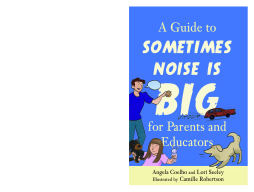
BOOK
A Guide to Sometimes Noise is Big for Parents and Educators
Angela Coelho | Lori Seeley | Camille Robertson
(2017)
Additional Information
Book Details
Abstract
Understand how children with autism experience the world around them with this simple guide. Learn why they might react unexpectedly to lights, noise, and even seemingly simple requests, and what you can do to help reduce sensory overload.
This accompanying guide to the children's picture book Sometimes Noise is Big takes the illustrations and gives a breakdown of what is happening in each picture, with practical tips on how to help children who struggle with sensory issues. This book can also be used as a standalone resource, and is ideal for supporting children aged 5+ with autism at home, in the classroom, and for raising awareness of autism and sensory issues.
This guide to Sometimes Noise is Big provides sign posts for parents and carers to provide that vital support. When we start to see through the individual autistic child's eyes we naturally begin to advocate for them and scaffold their success.
Adele Devine, Special Needs teacher and Co-Founder of SEN Assist autism software
Angela Coelho is mother to two children with ASD. Lori Seeley has 30 years' experience working in the field of Autism and Behavioural Support. They both live in British Columbia, Canada.
Extremely insightful and helps explain so many characteristics that go with having ASD.
Shannon-Lee Gillis, Mom to a child with autism
Table of Contents
| Section Title | Page | Action | Price |
|---|---|---|---|
| A Guide to Sometimes Noise is Big for Parents and Educators, by Angela Coelho and Lori Seeley, illustrated by Camille Robertson | 3 | ||
| 1. Introduction | 9 | ||
| 2. What Is Autism? | 10 | ||
| 3. Sensory Issues | 11 | ||
| 4. Light Sensitivity | 13 | ||
| 5. Noise Sensitivity | 15 | ||
| 6. Emotional Expression | 18 | ||
| 7. Overwhelming Feelings | 20 | ||
| 8. Texture Sensitivity—Clothing | 22 | ||
| 9. Food Aversions | 24 | ||
| 10. Eye Contact | 26 | ||
| 11. Focus and Overstimulation | 28 | ||
| 12. Self-Regulation | 30 | ||
| 13. Lining Up Objects | 32 | ||
| 14. Perspective | 34 | ||
| 15. Memory and Tasks | 36 | ||
| 16. Speech and Communication | 38 | ||
| 17. Filtering Sounds | 40 | ||
| 18. Parent Support | 42 | ||
| 19. Literal Thinking | 44 | ||
| 20. Similarities and Uniqueness | 46 | ||
| 21. Home Behaviors Versus School | 48 | ||
| 22. Tight Spaces | 50 | ||
| 23. Fight, Flight, and Freeze | 52 | ||
| 24. Stimming | 55 | ||
| 25. Social Interactions | 58 | ||
| 26. Learning Methods | 60 | ||
| 27. Problem-Solving Perspectives | 62 | ||
| 28. Singular Interests | 64 | ||
| 29. Strengths and Weaknesses | 66 | ||
| 30. Showing Love | 68 | ||
| 31. Conclusion | 70 | ||
| Common Acronyms and Terms | 71 | ||
| References | 76 | ||
| Further Reading | 78 | ||
| Index | 79 |
